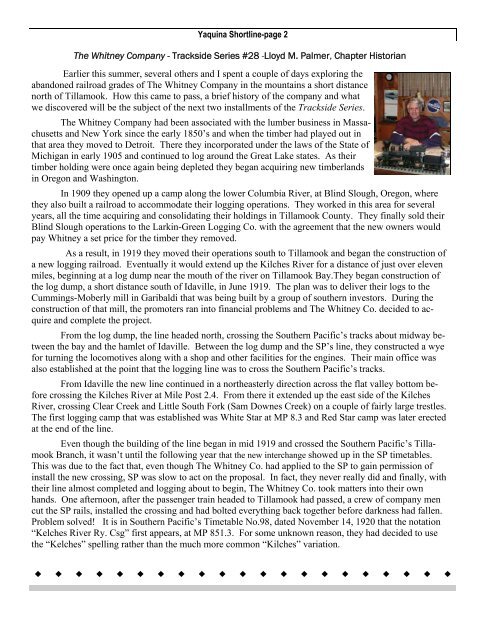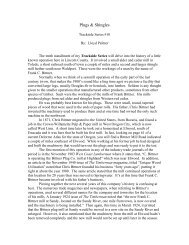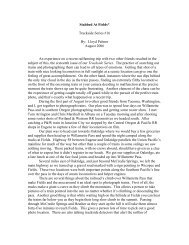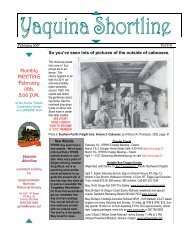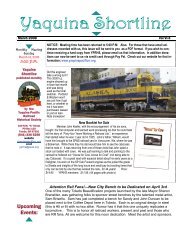The Whitney Company - Yaquina Pacific Railroad Historical Society
The Whitney Company - Yaquina Pacific Railroad Historical Society
The Whitney Company - Yaquina Pacific Railroad Historical Society
Create successful ePaper yourself
Turn your PDF publications into a flip-book with our unique Google optimized e-Paper software.
<strong>Yaquina</strong> Shortline-page 2<br />
<strong>The</strong> <strong>Whitney</strong> <strong>Company</strong> - Trackside Series #28 -Lloyd M. Palmer, Chapter Historian<br />
Earlier this summer, several others and I spent a couple of days exploring the<br />
abandoned railroad grades of <strong>The</strong> <strong>Whitney</strong> <strong>Company</strong> in the mountains a short distance<br />
north of Tillamook. How this came to pass, a brief history of the company and what<br />
we discovered will be the subject of the next two installments of the Trackside Series.<br />
<strong>The</strong> <strong>Whitney</strong> <strong>Company</strong> had been associated with the lumber business in Massachusetts<br />
and New York since the early 1850’s and when the timber had played out in<br />
that area they moved to Detroit. <strong>The</strong>re they incorporated under the laws of the State of<br />
Michigan in early 1905 and continued to log around the Great Lake states. As their<br />
timber holding were once again being depleted they began acquiring new timberlands<br />
in Oregon and Washington.<br />
In 1909 they opened up a camp along the lower Columbia River, at Blind Slough, Oregon, where<br />
they also built a railroad to accommodate their logging operations. <strong>The</strong>y worked in this area for several<br />
years, all the time acquiring and consolidating their holdings in Tillamook County. <strong>The</strong>y finally sold their<br />
Blind Slough operations to the Larkin-Green Logging Co. with the agreement that the new owners would<br />
pay <strong>Whitney</strong> a set price for the timber they removed.<br />
As a result, in 1919 they moved their operations south to Tillamook and began the construction of<br />
a new logging railroad. Eventually it would extend up the Kilches River for a distance of just over eleven<br />
miles, beginning at a log dump near the mouth of the river on Tillamook Bay.<strong>The</strong>y began construction of<br />
the log dump, a short distance south of Idaville, in June 1919. <strong>The</strong> plan was to deliver their logs to the<br />
Cummings-Moberly mill in Garibaldi that was being built by a group of southern investors. During the<br />
construction of that mill, the promoters ran into financial problems and <strong>The</strong> <strong>Whitney</strong> Co. decided to acquire<br />
and complete the project.<br />
From the log dump, the line headed north, crossing the Southern <strong>Pacific</strong>’s tracks about midway between<br />
the bay and the hamlet of Idaville. Between the log dump and the SP’s line, they constructed a wye<br />
for turning the locomotives along with a shop and other facilities for the engines. <strong>The</strong>ir main office was<br />
also established at the point that the logging line was to cross the Southern <strong>Pacific</strong>’s tracks.<br />
From Idaville the new line continued in a northeasterly direction across the flat valley bottom before<br />
crossing the Kilches River at Mile Post 2.4. From there it extended up the east side of the Kilches<br />
River, crossing Clear Creek and Little South Fork (Sam Downes Creek) on a couple of fairly large trestles.<br />
<strong>The</strong> first logging camp that was established was White Star at MP 8.3 and Red Star camp was later erected<br />
at the end of the line.<br />
Even though the building of the line began in mid 1919 and crossed the Southern <strong>Pacific</strong>’s Tillamook<br />
Branch, it wasn’t until the following year that the new interchange showed up in the SP timetables.<br />
This was due to the fact that, even though <strong>The</strong> <strong>Whitney</strong> Co. had applied to the SP to gain permission of<br />
install the new crossing, SP was slow to act on the proposal. In fact, they never really did and finally, with<br />
their line almost completed and logging about to begin, <strong>The</strong> <strong>Whitney</strong> Co. took matters into their own<br />
hands. One afternoon, after the passenger train headed to Tillamook had passed, a crew of company men<br />
cut the SP rails, installed the crossing and had bolted everything back together before darkness had fallen.<br />
Problem solved! It is in Southern <strong>Pacific</strong>’s Timetable No.98, dated November 14, 1920 that the notation<br />
“Kelches River Ry. Csg” first appears, at MP 851.3. For some unknown reason, they had decided to use<br />
the “Kelches” spelling rather than the much more common “Kilches” variation.
<strong>Yaquina</strong> Shortline-page 3<br />
<strong>The</strong> first landing was established near White Star camp and by the fall of 1921 logs were finally being sent<br />
down the newly built railroad, dumped into Tillamook Bay and towed to the mill in Garibaldi. Short spurs were<br />
built off of the mainline to access each setting and a passing siding had been built between Clear Creek and Sam<br />
Downes Creek to allow for the passing of the loaded log trains and the empties being delivered back to the woods.<br />
With the railroad being located up the valley of the Kilches River, this necessitated<br />
that the logs had to be skidded downhill to the landings. This is a tough way to have to log as<br />
it’s not only much more dangerous, it results in a lot more hang-ups with the turns of logs.<br />
Logs come down the steep hillsides much faster and it’s not uncommon for the rigging to go<br />
one side of a stump and the logs to go to the other side. When this happens, one of two things<br />
usually can happen. At worse, something breaks and at best, everything comes to an immediate<br />
halt until the hang-up can be eliminated.<br />
This problem plagued <strong>The</strong> <strong>Whitney</strong><br />
<strong>Company</strong> to the point that they<br />
#2 Blue Star Hoist and two-track incline railroad.<br />
decided to build an incline to the<br />
top of the ridge so as to be able to log uphill and at the<br />
same time, reach some new stands of timber. As a result,<br />
they began the construction of their famous incline<br />
in late 1924, a short distance below White Star camp, at<br />
MP 8.0 on the mainline.<strong>The</strong> incline left the mainline on<br />
a double-tracked curve and immediately began climbing<br />
the steep hillside to the east. <strong>The</strong> double track extended<br />
about half way up the hill and allowed the<br />
loaded log cars being let down the slope to pass the<br />
empty disconnect cars going up. <strong>The</strong> difference in elevation<br />
between the mainline along the Kilches River<br />
and the top of the ridge was about 1400’ and it was<br />
over half a mile long.<br />
A new camp, this one named Blue Star, was perched on the ridge right at the top of the incline. With virtually<br />
no flat ground to work with, a massive amount of dirt had to be moved to accommodate the necessary camp<br />
buildings along with the required hoist tower and hoisting donkey shed. This also necessitated the laying of a bit<br />
of unique track work in order to be able to position the loaded log cars for lowering, at the top of the incline, while<br />
also providing a separate track to return the empties to the woods. (see photo #3 on page 4)<br />
Extending outward from Blue Star, a new piece of logging railroad was built along the ridgeline in southeasterly<br />
direction. It hugged the eastern side of the ridge and eventually reached a distance of about a mile and a<br />
half before ending in a large saddle. In addition to this line, two short spurs were constructed, both about seven<br />
hundred feet long, to reach a couple of log landings.Logging operations at Blue Star began in early 1925 but were<br />
shut down by May of that year due to an economic downturn in the lumber markets. It wasn’t until early 1927 that<br />
logging again resumed but again, they lasted for only a few months before being suspended for a second time.<br />
Later that year <strong>The</strong> <strong>Whitney</strong> Co. was merged with the Hammond Lumber Co. holdings in the area and<br />
their holdings became part of the Hammond-Tillamook Lumber Co. Logging operations were once again started<br />
in the woods above the incline but lasted only for a short period of time before being shut down for the final time.<br />
List of 2011 Officers, Staff and Appointees (to date)<br />
Officers<br />
President - Bill Bain<br />
President - Bill Bain<br />
Vice President– Lane Plotner<br />
Vice President- Richard Cullison<br />
Secretary– Mark Seibert<br />
Secretary– Charlotte Paulsen<br />
Treasurer- Allan Preece<br />
National Director-Bob Topham<br />
National Director-Jim Webb<br />
Chapter Historian – Lloyd Palmer<br />
Chapter Historian – Lloyd Palmer<br />
Conductor-Tom Chandler<br />
Staff<br />
C.C.B.W—Leonard Freidberg<br />
Time Keeper-Allan Preece<br />
Appointees<br />
Senior Director– John Keefer<br />
Time Keeper- Ellie Kaps<br />
Webmaster –Misty Lambrecht<br />
Senior Director- Harry Dangler<br />
Small Engines - Lane Plotner
<strong>Yaquina</strong> Shortline-page 4<br />
Blue Star Logging Camp<br />
Incline RR<br />
All in all, the total time spent logging above the<br />
incline was less than a year. It seems like the company Bay City<br />
went to a lot of trouble and expense constructing the incline,<br />
building Blue Star camp and laying the woods line<br />
Idaville<br />
for what little logging took place up on the ridge. At any<br />
rate, it provided a colorful addition to the history of <strong>The</strong><br />
Tillamook<br />
<strong>Whitney</strong> Co.’s activities along the Kilches River.<br />
At this point you might be asking yourself, what<br />
brought on this renewed interest in the operations of <strong>The</strong><br />
<strong>Whitney</strong> Co. along the Kilches River? We have Gary Brooks, from Willamina, to thank for that. Gary is<br />
a master modeler that builds HO scale dioramas, his most recent one being the scene depicting Manary<br />
Logging <strong>Company</strong>’s Ark that is currently on display in the YPRHS museum.<br />
After finishing that project he was looking for a new subject to model and decided on <strong>The</strong> <strong>Whitney</strong><br />
<strong>Company</strong>’s Blue Star Camp that sat at the top of their incline. <strong>The</strong> finished product will rest on a 4 x<br />
8 sheet of plywood and be about three feet tall at it highest point. It will depict the camp as well as a portion<br />
of the top of the incline, and will include their Climax, the Molly-O, being winched up the hill. I’ve<br />
seen some preliminary photos of his progress on the diorama and believe me it’s going to be awesome<br />
when he’s finished with it.<br />
Gary started looking for photos that showed the scene and gathering information on <strong>Whitney</strong>’s<br />
operations. He contacted me and tapped several other logging railroad historians and as a result, rekindled<br />
an interest in the company. We all met at the Northwest Logging Modeler’s convention at Camp 18<br />
last spring to put our heads together and decided that we needed to visit the site where Blue Star had been<br />
located and to hike the incline. That outing, and what we found, will be the subject of the next installment<br />
of the Trackside Series so stay tuned.<br />
+++++++++++++++++++++++++++++++++++++++++++++++++++++++++++++++++<br />
On a nearby historical note. An earlier Ford Foundation Leadership Development Class is now<br />
on Phase I of the development of a Scenic Pull-Off at mile post 6.5 on the <strong>Yaquina</strong> River Road. <strong>The</strong><br />
group is presently raising funds for Phase II, which will include seating and signage. <strong>The</strong> group has<br />
asked YPRHS for assistance as the signage could include representation of the historic rail line .<br />
Kilchis River


